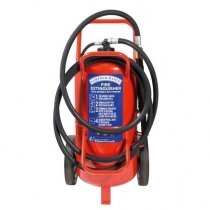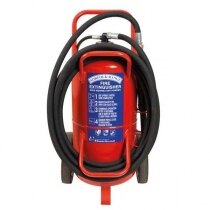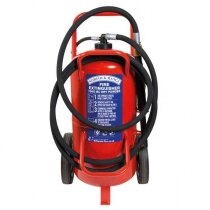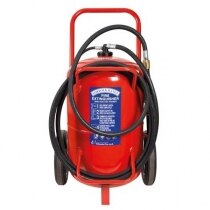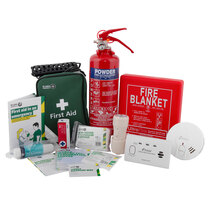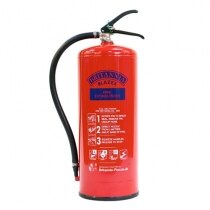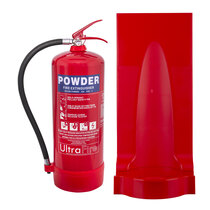-
Contact
Sales & Customer Service
0800 612 6537 support@safelincs.co.uk Live ChatDelivery Enquiries
0800 077 6149 - Resources
Fire & Safety Solutions
CALL OUR TEAM NOW 0800 612 6537
Also FREE from UK mobiles
FREE Delivery
on marked products
Live Chat - Online
Instant help & Advice
Trade Discounts
and exclusive pricing
0% Credit Available
Open an account now
5 Star Customer Feedback
Dry Powder Fire Extinguishers
Every workplace needs fire protection you can trust. A dry powder fire extinguisher provides protection, tackling Class A, B, and C fires with proven effectiveness. Whether you're protecting a petrol forecourt or warehousing, these extinguishers deliver reliable performance when seconds count. They work by smothering flames and interrupting the chemical reaction that feeds fire, creating a barrier between fuel and oxygen. The effectiveness of a dry powder fire extinguisher Dry powder fire extinguishers work by smothering flames and interrupting the chemical reaction that feeds fire. The powder creates a barrier between the fuel and oxygen, stopping the fire from spreading. This makes them incredibly effective on multiple fire types, from burning paper and wood to flammable liquids and gases. How do you choose the right size? The size of a fire extinguisher depends on the area being protected and the level of fire risk. A 1kg extinguisher is suitable for small offices or vehicles, but a 6kg or 9kg extinguisher works better for larger spaces or higher-risk areas. Our range covers everything from compact 1kg models to heavy-duty 9kg extinguishers. Where should dry powder extinguishers be placed? Position your dry powder fire extinguisher near exit routes, but not so close that fire might block access. Mount them at a comfortable height, approximately 1.5 metres from the floor to the handle. Keep them visible and accessible, away from heat sources and moisture. Do you need special maintenance? Regular maintenance ensures your extinguisher is always ready for action. Check the pressure gauge monthly, inspect for damage, and arrange annual servicing by a qualified technician. Replace fire extinguishers that show signs of corrosion or damage immediately. If stored outside, steel powder extinguishers should be protected (for example, with cabinets) to protect them from corrosion. Dry powder fire extinguisher limitations Dry powder extinguishers aren't suitable for electrical fires over 1000 volts or Class F cooking oil fires. The powder can also create a mess and may damage sensitive equipment. Consider these factors when choosing your fire protection strategy. They are better for use outside or in wide open spaces due to visibility issues on discharge as well as the risk of inhalation which can cause health risks. Are there alternatives to consider? Foam extinguishers and water mist extinguishers work well for Class A and fires involving electrical equipment, and create less mess. Carbon dioxide extinguishers are suitable for electrical fires, leaving no residue. However, dry powder extinguishers remain the most versatile choice for mixed fire risks in locations with open space. For a detailed comparison of your options, see our guide on foam vs powder fire extinguishers. Our dry powder fire extinguisher range features models from trusted manufacturers, all of which meet British Standards. You'll find everything from budget-friendly options to premium models with advanced features. Each extinguisher comes with clear instructions and safety information. Ready to protect your premises? Explore our comprehensive range of powder fire extinguishers and discover the ideal solution for your specific fire safety requirements. Frequently Asked Questions (FAQs) Can you use a dry powder fire extinguisher indoors? You can use a dry powder fire extinguisher indoors, but it's not recommended for most indoor spaces. The powder spreads quickly, reducing visibility and making it harder to escape. It can also cause respiratory problems and stomach irritation if inhaled. However, they're suitable for some indoor areas, such as boiler rooms, garages, and specific warehouses, where the benefits outweigh the risks. Why are dry powder extinguishers better for outdoor use? Dry powder extinguishers work effectively outdoors because they won't freeze, unlike water-based extinguishers. They're perfect for garage forecourts, open workshops, goods yards, and vehicles. The powder spreads effectively in open areas without creating the visibility and breathing problems you'd get in enclosed spaces. Plus, there's better ventilation outdoors to disperse the powder after use. What size dry powder fire extinguisher do you need for a van or lorry? For vans and smaller commercial vehicles, a 1kg or 2kg dry powder extinguisher works well. Lorry cabs typically need a 2kg extinguisher, but larger commercial trucks often carry 6kg extinguishers. The slimline powder extinguishers with transport brackets are ideal for vehicles as they fit neatly and securely. Check your vehicle's specific requirements, as some industries have particular standards. Do dry powder extinguishers need annual servicing? Traditional dry powder extinguishers need annual servicing by a qualified technician. However, some models, like P50 Service-Free Fire Extinguishers, don't require yearly company servicing, which reduces your maintenance costs. How do you clean up after using a dry powder extinguisher? Cleaning up powder residue takes patience but isn't complicated. Sweep or vacuum up the bulk of the powder first, then wipe surfaces with a damp cloth. Don't use water immediately as it can create a paste. The powder is non-toxic but can irritate the skin and eyes; therefore, wear gloves and avoid inhaling dust. Soft furnishings are challenging to clean, which is why powder extinguishers are better suited for hard-surfaced areas.
Read more about dry powder fire extinguishers...
Britannia Norfolk 50kg Wheeled Monnex Powder Extinguisher
This Monnex powder wheeled extinguisher can be used for Class B and C fires, as well as near live electrical equipment, with a discharge range of up to 14 metres.
- 50kg capacity and designed to combat Class B and Class C fires
- 10 year warranty
- CE Marked
- Monnex powder extinguishing agent
Britannia Norfolk 60kg Wheeled ABC Dry Powder Extinguisher
This Norfolk wheeled extinguisher is designed to tackle Class A, B and C fires, with a discharge duration of 38 seconds over a range of 14 metres.
- 60kg capacity and suitable for Class A, Class B and Class C fires
- 10 year warranty
- CE Marked
- ABC Dry Powder extinguishant
Britannia Norfolk 63kg Wheeled Monnex Powder Extinguisher
This Britannia Norfolk wheeled extinguisher is ideal for industrial-scale Class B and C fires due to the expansive nature of Monnex Powder, as well as near live electrical equipment due to it being a non-conducitve chemical.
- 63kg capacity and ideal for large Class B and Class C fires
- 10 year warranty
- CE Marked
- Monnex Powder extinguishing agent
Britannia Norfolk 70kg Wheeled BC Dry Powder Extinguisher
This Norfolk wheeled extinguisher is supplied with a 5 metre hose and can discharge up to 40 seconds across 14 metres.
- 70kg capacity and suitable use on for Class B and Class C fires
- 10 year warranty
- CE Marked
- BC dry powder extinguishant
Britannia Norfolk 100kg Wheeled ABC Dry Powder Extinguisher
This Norfolk wheeled 100kg powder extinguisher is designed for use on industrial-scale Class A, B and C fires, providing up to 80 seconds of continuous use over a range of 14 metres.
- 100kg capacity and designed to combat Class A, Class B and Class C fires
- 10 year warranty
- CE marked
- ABC dry powder extinguishant
Home Working Fire Safety Kit - Safelincs
- Fire blanket included for emergency escape
- Supplied with a portable powder extinguisher and emergency light
- St John Ambulance first aid kit provides the essentials for minor injuries
- Also supplied with an optical smoke alarm and CO alarm
- Protect your home office / home working environment
9kg Powder Fire Extinguisher - Britannia
An extremely powerful fire-fighter, this large powder extinguisher is ideal for industrial environments where highly flammable materials may be present.
- Extinguisher Rating: 34A, 233B, C
- 10 year warranty - Exclusive to Safelincs
- Kitemarked to BS EN 3: 1996 and CE marked
- UK Manufactured
9kg Powder Fire Extinguisher & Single Extinguisher Stand Special Offer
Ideal for warehouse loading bays and garage forecourts, this special offer is comprised of a 9kg powder fire extinguisher coupled with a heavy duty modular single extinguisher stand.
- FREE next working day delivery
- Powder Extinguisher Rating: 43A, 233B, C and Electrical
- Heavy duty modular stand with moulded base system
- Ideal for loading bays and garage forecourts, etc.
Page 2 (28 of 28 Products)
How do powder fire extinguishers work?
Dry powder fire extinguishers remove oxygen from the fire by smothering the flames in a thin dust layer. They are filled with the active agent monoammonium phosphate and the fine particles spread easily across the fire when discharged, cutting off the fire from the surrounding oxygen in the air. This acts to supress the fire and ultimately extinguish it.
Dry powder fire extinguishers are suitable for use on Class A, B and C fires. They are also safe for use on fires involving live electrical equipment.
- Class A (solid materials such as paper, wood, cardboard, plastics etc.)
- Class B (flammable liquids or liquefiable solids such as paint, oil, wax etc.)
- Class C (flammable gases such as natural gas, LPG etc.)
Where to use dry powder fire extinguishers
Powder fire extinguishers should be used outdoors, with the exception of boiler rooms, garages and some warehouses. Dry powder fire extinguishers are versatile and are recommended for use on garage forecourts, open workshops, goods yards and on vehicles. They are ideal for use outdoors as they will not be affected by freezing conditions like water-based extinguishers.
Using powder fire extinguishers indoors is not recommended as it could reduce visibility which may make it difficult to escape. When discharged indoors, the dry powder spreads quickly across a wide area. Dry powder fire extinguishers are non-toxic, however, there is a high risk of inhalation which can cause health problems such as respiratory issues and stomach irritation. Contact with the skin can cause redness and itching and contact with eyes can be harmful. Soft furnishings that come into contact with the powder are also very hard to clean.
Are dry powder fire extinguishers banned?
Powder fire extinguishers are not banned as they are not toxic, but they are mainly recommended for outdoor use, due to the possibility of reduced visibility and a risk of inhalation when used indoors.
ABC Powder Fire Extinguishers
An ‘ABC’ Powder Fire Extinguisher (or dry powder fire extinguisher), often referred to as general or multi-purpose, is designed to tackle Class A, B and C fires. This type of extinguisher typically use ammonium or a mono-ammonium phosphate mixed with other powders and works by smothering the fire, to starve it of oxygen. Dry powder extinguishers can be used in a number of locations but are most often found at petrol forecourts, in vehicles and garages, or where fire involving flammable liquids and gases could be a hazard. Whilst these extinguishers are versatile, being suitable for use on most common fire types, their use indoors is not encouraged due to the mess powder creates and the potential impairment of vision and effects on respiration it can cause.




















